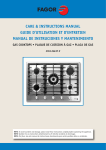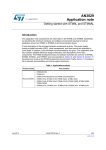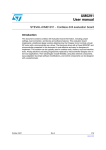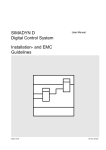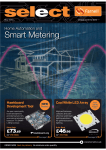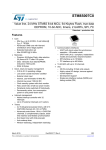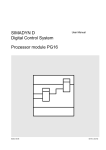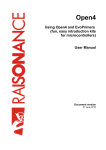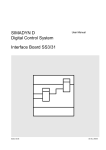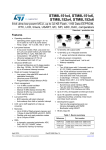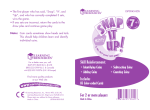Download Counter with STM8L101xx low-power microcontroller
Transcript
UM0789 User manual Counter with STM8L101xx low-power microcontroller and LCD Introduction The demonstration board STEVAL-IAS003V1 has been designed to be used as example for applications where directly driven LCD and associated programmable functionality are needed. Targeted applications are medical, healthcare, battery operated counters, metering, among many others. The board demonstrates STM8L101xx microcontroller low power consumption. The demonstration firmware is consequently written to take advantage of the low power modes available on this device. It allows to achieve an average current consumption lower than 1.6 µA for the whole application including the direct LCD software driver. Figure 1. September 2009 STEVAL-IAS003V1 demonstration board Doc ID 16240 Rev 1 1/11 www.st.com Contents UM0789 Contents 1 Main features . . . . . . . . . . . . . . . . . . . . . . . . . . . . . . . . . . . . . . . . . . . . . . . 3 1.1 Used components . . . . . . . . . . . . . . . . . . . . . . . . . . . . . . . . . . . . . . . . . . . 3 1.2 Circuit schematic . . . . . . . . . . . . . . . . . . . . . . . . . . . . . . . . . . . . . . . . . . . . 4 2 Basic principles . . . . . . . . . . . . . . . . . . . . . . . . . . . . . . . . . . . . . . . . . . . . . 5 3 Additional features . . . . . . . . . . . . . . . . . . . . . . . . . . . . . . . . . . . . . . . . . . 7 3.1 LCD decoding . . . . . . . . . . . . . . . . . . . . . . . . . . . . . . . . . . . . . . . . . . . . . . . 8 4 Conclusion . . . . . . . . . . . . . . . . . . . . . . . . . . . . . . . . . . . . . . . . . . . . . . . . . 9 5 Revision history . . . . . . . . . . . . . . . . . . . . . . . . . . . . . . . . . . . . . . . . . . . 10 2/11 Doc ID 16240 Rev 1 UM0789 1 Main features Main features ● 1.6 µA consumption @ 36 Hz refresh rate ● 3 digit LCD glass driven by software ● 2 buttons ● CR1220 battery operated ● Minimum external components: – 1.1 only 2 capacitors on top of mandatory parts (battery, LCD, MCU, buttons) ● Low-cost PCB (single layer) ● RoHS compliant Used components ● 1x STM8L101 ● 1x 3 digit LCD glass, 23 segments, single common electrode ● 1x ceramic capacitor 47 nF on supply lines ● 1x ceramic capacitor 10 nF on RESET line ● 2x button ● 1x battery CR1220 ● 1x PCB ● 1x SWIM connector (only for evaluation purpose) ● 1x jumper (only for evaluation purpose/ammeter connection) Doc ID 16240 Rev 1 3/11 Main features 1.2 UM0789 Circuit schematic Figure 2. STEVAL-IAS003V1 schematic diagram 5 "UTTON? 0" % $ # $0 % $ # $0 % $ # " 0 # #AP3EMI .# )# 6SS "UTTON? % $ # $0 % $ # $0 % $ # " ! & ' " ! & ' " ! & ' #/- ! & ' " ! & ' " ! & ' #/- ,#$?DIGIT 0" # #AP3EMI .# 6SS 6SS "UTTON? $0 # $ % 37) 6DD 6DD 37)6SS .234 4/11 (EADER 6DD 6DD # N& 0 (EADER 0 " ! & ' " ! & ' (EADER #/% $ # " ! & ' 0 0$ 0$ 0$ 0$ 0" 0" 0" 0" 0" 0" 0" 0" 0$ 0$ 0$ 0$ 6SS 0! 0! 0! 0! 0! 0! 633 6$$ 5 34-, 0# 0# 0# 0# 0# 0# 0# 0! .234 $0 # $ % "UTTON? # #AP3EMI N& "4 "ATTERY 6SS 6SS !-V Doc ID 16240 Rev 1 UM0789 2 Basic principles Basic principles The main task of this demonstration board is to drive an LCD display. There are different ways to drive an LCD: the LCD can feature an integrated driver which communicates via an SPI bus, or it can be controlled directly through its segments. This application directly drives the LCD segments. LCD glasses have plenty of segment electrodes, and one or several common electrodes. To make a character or segment visible, a voltage level has to be applied between the segment and the appropriate common electrode. To keep the character or segment invisible, a voltage level equal to the common electrode voltage must be applied to segment 1. To prevent electrolytic damage on liquid crystals, an AC voltage has to be applied on the electrodes. As only DC supply voltage is available on the board, the MCU must change regularly the voltage polarity between the segment and the common electrode. Figure 3. COM stands for common segment; SEG1 for segment 1; and SEG2 for segment 2 #/6DD 6SS 3%' 6DD 6SS 3%' 6DD 6SS !-V For more details about LCD drive, please refer to AN1048 and AN2687. In order to minimize current consumption, the STM8L101xx is kept in Active-halt low power mode most of the time. The MCU is periodically woken up from this mode by an autowakeup timer. This timer is configured to wake up the MCU by generating an interrupt every 28 ms to achieve an LCD refresh rate of 36 Hz. This frequency is the best compromise between consumption, which increases with the frequency, and flickering which appears at low refresh rates The interrupt service routine performs the toggling of LCD control signals to make sure there is no DC bias between segments and common electrodes. The routine placement is aligned with memory organization to fill STM8 pipeline prefetch buffers efficiently. Doc ID 16240 Rev 1 5/11 Basic principles UM0789 To save power, a new feature has been implemented on STM8L microcontrollers: when the AL bit is set in the global configuration register (CFG_GCR) and the MCU is woken up from low power mode, it goes back to low power mode as soon as the interrupt service routine (ISR)execution is complete. There is no need to restore the context, return to the main program and execute a HALT instruction again. 6/11 Doc ID 16240 Rev 1 UM0789 3 Additional features Additional features Each button corresponds to a different ISR which allows to compare two possible solutions. The functions performed by each ISR are identical but their implementation differs. Both ISRs update the value shown on the LCD, refresh the LCD as long as the button is pressed (AWU is disabled during this time), and perform a periodic test on the button. Once the button is pressed, the MCU is woken up as long as the button remains pressed. The MCU is consequently in full operating mode. Several procedures to decrease power consumption have been used in demo application: ● slowing down core frequency, when it brings an advantage ● moving code to the RAM, when it brings an advantage ● using WFE/WFI mode ● dynamic pull up configuration for buttons Slowing down the core frequency brings an advantage mainly if the MCU performs periodically the same operation such as a button check. Once the MCU has entered the deepest low power mode (Active-halt or Halt), slowing down the core results in higher consumption than executing the code at high speed. Faster code execution changes the ratio between Run mode and Active-halt/Halt mode, resulting in an overall lower consumption. The left button is associated with ISR code located in RAM memory. To slow down the core and achieve lower consumption, the clock frequency is divided by a factor of 8. The ISR consequently contains a single while() loop performing a sequence of NOP instructions and button check. The approximate consumption in this mode ranges from 350 to 380 µA. The right button is associated with ISR code located in Flash memory (main loop). The core runs at high frequency while the instructions are executed. To save power, a brand-new Wait for event mode is used. In this mode, the core is stopped and waits for an event which is associated with a peripheral, in this case timer 2 (TIM2). TIM2 generates a delay which replaces the while() loop implemented in the Left button ISR. Once the MCU has entered low power mode, the clock frequency is divided. In this mode, the approximate consumption ranges from 240 to 270 µA. Once button is pressed, it will ground an associated pin. This pin has an internal pull up of around 45 kΩ, connected to Vcc. It means that, a current of 67 µA is drawn from the battery by the I/Os. To save on power consumption, a dynamic connection of this pull up is implemented. The pull up is set only for a short period of time when the software performs a check on the button. It is then disabled. This sequence is repeated every 6.4 ms. It dramatically reduces the current consumption on the I/Os. The usual problem of extra consumption generated by the toggling of pins left floating does not occur in this situation: a proper level is guaranteed while the button is pressed, except for a few ms when the button is released. This time does not exceed one period of button state check. Timing is managed by TIM2 or by a software delay. Doc ID 16240 Rev 1 7/11 Additional features 3.1 UM0789 LCD decoding To allow using a single layer PCB, the LCD display is connected directly to IOs in the simplest way from design point of view. As a result, the software decodes directly the characters to control the corresponding IOs. The following define statements must be used to associate the active segments with each character to be shown on the LCD: #define LCD_CHAR_0 (LCD_A + LCD_B + LCD_C + LCD_D + LCD_E + LCD_F ) The above definitions are stored in the LCD_VALUE[] array which contains all possible character definitions. Simple indexing could be used to read the character definitions. These definitions are then used by the decoding function to set the appropriate STM8L101xx pins to 0 (invisible segment) or to 1 (visible segment). To update the LCD, a simple inversion of all IOs is required. The common electrode is set to 0 during LCD update. For LCD update, a simple inversion of all I/O's is used. 8/11 Doc ID 16240 Rev 1 UM0789 4 Conclusion Conclusion This example could be used for many different applications. User could modify the attached software easily to implement any additional functionalities and features. Doc ID 16240 Rev 1 9/11 Revision history 5 UM0789 Revision history Table 1. 10/11 Document revision history Date Revision 17-Sep-2009 1 Changes Initial release. Doc ID 16240 Rev 1 UM0789 Please Read Carefully: Information in this document is provided solely in connection with ST products. STMicroelectronics NV and its subsidiaries (“ST”) reserve the right to make changes, corrections, modifications or improvements, to this document, and the products and services described herein at any time, without notice. All ST products are sold pursuant to ST’s terms and conditions of sale. Purchasers are solely responsible for the choice, selection and use of the ST products and services described herein, and ST assumes no liability whatsoever relating to the choice, selection or use of the ST products and services described herein. No license, express or implied, by estoppel or otherwise, to any intellectual property rights is granted under this document. If any part of this document refers to any third party products or services it shall not be deemed a license grant by ST for the use of such third party products or services, or any intellectual property contained therein or considered as a warranty covering the use in any manner whatsoever of such third party products or services or any intellectual property contained therein. UNLESS OTHERWISE SET FORTH IN ST’S TERMS AND CONDITIONS OF SALE ST DISCLAIMS ANY EXPRESS OR IMPLIED WARRANTY WITH RESPECT TO THE USE AND/OR SALE OF ST PRODUCTS INCLUDING WITHOUT LIMITATION IMPLIED WARRANTIES OF MERCHANTABILITY, FITNESS FOR A PARTICULAR PURPOSE (AND THEIR EQUIVALENTS UNDER THE LAWS OF ANY JURISDICTION), OR INFRINGEMENT OF ANY PATENT, COPYRIGHT OR OTHER INTELLECTUAL PROPERTY RIGHT. UNLESS EXPRESSLY APPROVED IN WRITING BY AN AUTHORIZED ST REPRESENTATIVE, ST PRODUCTS ARE NOT RECOMMENDED, AUTHORIZED OR WARRANTED FOR USE IN MILITARY, AIR CRAFT, SPACE, LIFE SAVING, OR LIFE SUSTAINING APPLICATIONS, NOR IN PRODUCTS OR SYSTEMS WHERE FAILURE OR MALFUNCTION MAY RESULT IN PERSONAL INJURY, DEATH, OR SEVERE PROPERTY OR ENVIRONMENTAL DAMAGE. ST PRODUCTS WHICH ARE NOT SPECIFIED AS "AUTOMOTIVE GRADE" MAY ONLY BE USED IN AUTOMOTIVE APPLICATIONS AT USER’S OWN RISK. Resale of ST products with provisions different from the statements and/or technical features set forth in this document shall immediately void any warranty granted by ST for the ST product or service described herein and shall not create or extend in any manner whatsoever, any liability of ST. ST and the ST logo are trademarks or registered trademarks of ST in various countries. Information in this document supersedes and replaces all information previously supplied. The ST logo is a registered trademark of STMicroelectronics. All other names are the property of their respective owners. © 2009 STMicroelectronics - All rights reserved STMicroelectronics group of companies Australia - Belgium - Brazil - Canada - China - Czech Republic - Finland - France - Germany - Hong Kong - India - Israel - Italy - Japan Malaysia - Malta - Morocco - Philippines - Singapore - Spain - Sweden - Switzerland - United Kingdom - United States of America www.st.com Doc ID 16240 Rev 1 11/11











